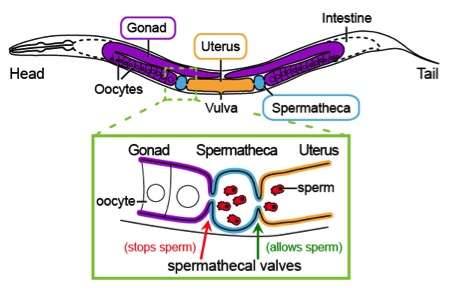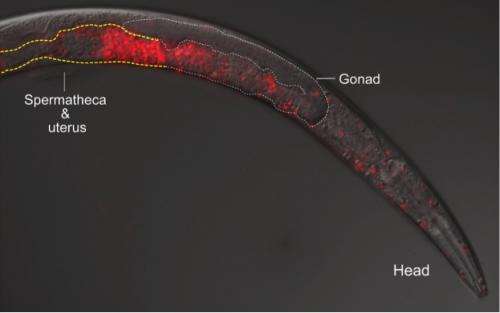'Killer sperm' prevents mating between worm species

The classic definition of a biological species is the ability to breed within its group, and the inability to breed outside it. For instance, breeding a horse and a donkey may result in a live mule offspring, but mules are nearly always sterile due to genomic incompatibility between the two species.
The vast majority of the time, mating across species is merely unsuccessful in producing offspring. However, when researchers at the University of Maryland and the University of Toronto mated Caenorhabditis worms of different species, they found that the lifespan of the female worms and their number of progeny were drastically reduced compared with females that mated with the same species. In addition, females that survived cross-species mating were often sterile, even if they subsequently mated with their own species.
When the researchers observed the sterile and dying female worms under a microscope using a fluorescent stain to visualize sperm in live worms, they discovered that the foreign sperm had broken through the sphincter of the worm's uterus and invaded the ovaries. There, the sperm prematurely fertilized the eggs, which were then unable to develop into viable offspring. The sperm eventually destroyed the ovaries, resulting in sterility. The sperm then traveled farther throughout the worm's body, resulting in tissue damage and death.
"Our findings were quite surprising because females typically just select sperm from males of their own species during fertilization, an action that does not lead to long-term consequences because there is no gene flow between the species," said Asher Cutter, associate professor of ecology and evolutionary biology at the University of Toronto.

The results suggest the interaction between sperm and the female reproductive tract as a novel reason for failed mating in worms, noted Eric Haag, associate professor of biology at UMD. "The findings may be worth investigating in other species as well, because similar coordination problems may be relevant to infertility in other organisms," he added.
The study, which was led by graduate students Gavin Woodruff from UMD and Janice Ting from the University of Toronto, was published on July 29, 2014 in the journal PLOS Biology. Woodruff is now a postdoctoral researcher at the Forestry and Forest Research Products Institute in Japan.
The researchers believe the "killer sperm" may be the result of a divergence in the evolution of worm species' sexual organs—in particular, the ability of sperm to physically compete with one another. When a female worm mates with multiple males, the sperm jostle each other, competing for access to the eggs. Female worms' bodies must be able to withstand this competition to survive and produce offspring. The researchers hypothesize that the aggressiveness of the sperm and the ability of the uterus to tolerate the sperm are the same within a single species, but not across multiple species. Thus, a female from a species with less active sperm may not be able to tolerate the aggressive sperm from a different species.
There is evidence for this theory. In the current study, three species of hermaphrodite worms—which produce their own sperm and fertilize their own eggs to reproduce—were especially susceptible to sterility and death when mated with males of other species. The hermaphrodite uterus may have evolved to tolerate "gentler" sperm, but not the larger, more active sperm of non-hermaphrodite species, according to the researchers.
"We found that hermaphrodites can sense, and try to avoid, males of species that can harm them," added Haag.
This instance of lethal cross-species mating is of special interest to evolutionary biologists, Haag notes, because it's unclear how the many species on earth—8.7 million, not counting bacteria, according to an estimate published in Nature—remain distinct from each other.
"Punishing cross-species mating by sterility or death would be a powerful evolutionary way to maintain a species barrier," Haag said.
However, evolution usually leaves a few survivors behind, even in the most adverse conditions. The researchers had previously found that the harmful crosses between species nevertheless can produce a few viable offspring. Haag plans to follow up on this study by investigating how these hybrid worms behave when they are bred to different species.
More information: PLOS Biology,DOI: 10.1371/journal.pbio.1001915.
Journal information: PLoS Biology , Nature
Provided by University of Maryland

















